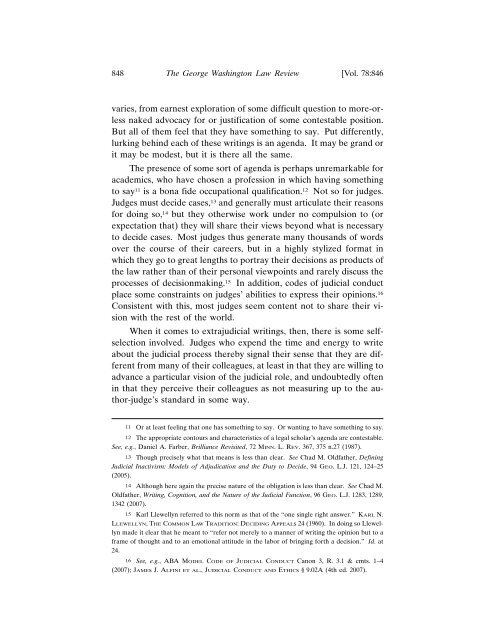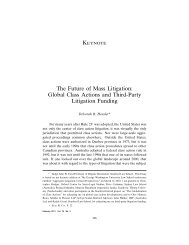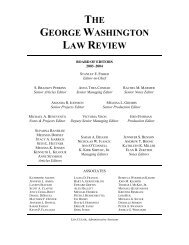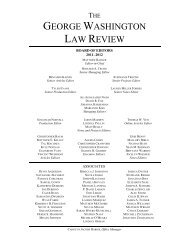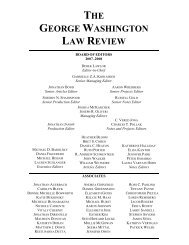View PDF - The George Washington Law Review
View PDF - The George Washington Law Review
View PDF - The George Washington Law Review
You also want an ePaper? Increase the reach of your titles
YUMPU automatically turns print PDFs into web optimized ePapers that Google loves.
848 <strong>The</strong> <strong>George</strong> <strong>Washington</strong> <strong>Law</strong> <strong>Review</strong> [Vol. 78:846<br />
varies, from earnest exploration of some difficult question to more-orless<br />
naked advocacy for or justification of some contestable position.<br />
But all of them feel that they have something to say. Put differently,<br />
lurking behind each of these writings is an agenda. It may be grand or<br />
it may be modest, but it is there all the same.<br />
<strong>The</strong> presence of some sort of agenda is perhaps unremarkable for<br />
academics, who have chosen a profession in which having something<br />
to say 11 is a bona fide occupational qualification. 12 Not so for judges.<br />
Judges must decide cases, 13 and generally must articulate their reasons<br />
for doing so, 14 but they otherwise work under no compulsion to (or<br />
expectation that) they will share their views beyond what is necessary<br />
to decide cases. Most judges thus generate many thousands of words<br />
over the course of their careers, but in a highly stylized format in<br />
which they go to great lengths to portray their decisions as products of<br />
the law rather than of their personal viewpoints and rarely discuss the<br />
processes of decisionmaking. 15 In addition, codes of judicial conduct<br />
place some constraints on judges’ abilities to express their opinions. 16<br />
Consistent with this, most judges seem content not to share their vision<br />
with the rest of the world.<br />
When it comes to extrajudicial writings, then, there is some selfselection<br />
involved. Judges who expend the time and energy to write<br />
about the judicial process thereby signal their sense that they are different<br />
from many of their colleagues, at least in that they are willing to<br />
advance a particular vision of the judicial role, and undoubtedly often<br />
in that they perceive their colleagues as not measuring up to the author-judge’s<br />
standard in some way.<br />
11 Or at least feeling that one has something to say. Or wanting to have something to say.<br />
12 <strong>The</strong> appropriate contours and characteristics of a legal scholar’s agenda are contestable.<br />
See, e.g., Daniel A. Farber, Brilliance Revisited, 72 MINN. L. REV. 367, 375 n.27 (1987).<br />
13 Though precisely what that means is less than clear. See Chad M. Oldfather, Defining<br />
Judicial Inactivism: Models of Adjudication and the Duty to Decide, 94 GEO. L.J. 121, 124–25<br />
(2005).<br />
14 Although here again the precise nature of the obligation is less than clear. See Chad M.<br />
Oldfather, Writing, Cognition, and the Nature of the Judicial Function, 96 GEO. L.J. 1283, 1289,<br />
1342 (2007).<br />
15 Karl Llewellyn referred to this norm as that of the “one single right answer.” KARL N.<br />
LLEWELLYN, THE COMMON LAW TRADITION: DECIDING APPEALS 24 (1960). In doing so Llewellyn<br />
made it clear that he meant to “refer not merely to a manner of writing the opinion but to a<br />
frame of thought and to an emotional attitude in the labor of bringing forth a decision.” Id. at<br />
24.<br />
16 See, e.g., ABA MODEL CODE OF JUDICIAL CONDUCT Canon 3, R. 3.1 & cmts. 1–4<br />
(2007); JAMES J. ALFINI ET AL., JUDICIAL CONDUCT AND ETHICS § 9.02A (4th ed. 2007).


